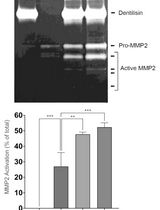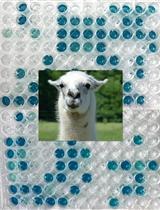- EN - English
- CN - 中文
Isolation of Ribosomal Particles from the Unicellular Cyanobacterium Synechocystis sp. PCC 6803
从单细胞蓝细菌集胞藻PCC 6803 中分离核糖体颗粒
发布: 2017年03月20日第7卷第6期 DOI: 10.21769/BioProtoc.2176 浏览次数: 8915
评审: Dennis NürnbergAksiniya AsenovaManuel Miras Marin

相关实验方案

通过制备连续聚丙烯酰胺凝胶电泳和凝胶酶谱分析法纯化来自梭状龋齿螺旋体的天然Dentilisin复合物及其功能分析
Pachiyappan Kamarajan [...] Yvonne L. Kapila
2024年04月05日 1655 阅读
Abstract
Isolation of ribosomal particles is an essential step in the study of ribosomal components as well as in the analysis of trans-acting factors that interact with the ribosome to regulate protein synthesis and modulate the expression profile of the cell in response to different environmental conditions. In this protocol, we describe a procedure for the isolation of 70S ribosomes from the unicellular cyanobacterium Synechocystis sp. PCC 6803 (hereafter Synechocystis). We have successfully used this protocol in our study of the cyanobacterial ribosomal-associated protein LrtA, which is a homologue of bacterial HPF (hibernation promoting factor) (Galmozzi et al., 2016).
Keywords: Ribosome (核糖体)Background
Few biochemical studies have been reported for cyanobacterial ribosomes. Anabaena variabilis strain M3 (PCC 7118, ATCC 27892) 70S ribosomal particles have been isolated by differential centrifugation and then, ribosomal proteins were analysed by two-dimensional electrophoresis (Sato et al., 1998). Ribosomes have also been prepared from Synechococcus sp. PCC 6301 cells using a protocol combining differential centrifugation and sucrose step gradients (Sugita et al., 2000). Fractionation of cell extracts by differential centrifugation has also been employed in the preparation of ribosomal samples for the development of an in vitro translation system in different Synechococcus strains (Mutsuda and Sugiura, 2006). The method described here for Synechocystis, based on the one described for Synechococcus (Sugita et al., 2000), allows purification of ribosomal particles using ultracentrifugation of linear sucrose gradients.
Materials and Reagents
- Centrifuge tubes, polypropylene 15 ml (Beckman Coulter, catalog number: 342082 )
- 1.5 ml microcentrifuge tubes (Microtubes) (Corning, Axygen®, catalog number: MCT-150-C )
- 1.5 ml polystyrene spectrophotometer cuvettes (KARTELL SPA CIA DELLE INDUSTRIE, catalog number: 1938 )
- Ultracentrifuge thin-wall polyallomer tubes 13.2 ml (Beckman Coulter, catalog number: 331372 )
- 0.45 μm Millipore filter (MILLEX-HV PVDF) (EMD Millipore, catalog number: SLHV033RS )
- Alumina type A-5 (Sigma-Aldrich, catalog number: A2039 )
Note: This product has been discontinued. - Micropipette tips (200 μl) (Daslab, catalog number: 162001X )
- Micropipette tips (1,000 μl) (Daslab, catalog number: 162222X )
- Silicone tubing (VWR, catalog number: 228-0713 )
- Synechocystis sp. PCC 6803 cells (Pasteur Culture Collection of Cyanobacteria)
- Milli-Q water
- Distilled water
- Sodium nitrate (NaNO3) (AppliChem, catalog number: 141702 )
- Sodium bicarbonate (NaHCO3) (AppliChem, catalog number: 141638 )
- Potassium phosphate dibasic (K2HPO4) (AppliChem, catalog number: 141512 )
- Magnesium sulfate heptahydrate (MgSO4·7H2O) (Duchefa Biochemie, catalog number: M0513 )
- Citric acid monohydrate (C6H8O7·H2O) (EMD Millipore, catalog number: 100244 )
- EDTA-Na2 (Duchefa Biochemie, catalog number: E0511 )
- Calcium chloride dihydrate (CaCl2·2H2O) (Merck, catalog number: 2382 )
- Citrate Fe-NH4 (Sigma-Aldrich, catalog number: F5879 )
- Sodium phosphate (Na2CO3) (Merck, catalog number: 6392 )
- Boric acid (H3BO3) (EMD Millipore, catalog number: 100165 )
- Manganese(II) chloride tetrahydrate (MnCl2·4H2O) (EMD Millipore, catalog number: 1059270 )
- Sodium molybdate dehydrate (Na2MoO4·2H2O) (Merck, catalog number: 6521 )
- Zinc sulfate heptahydrate (ZnSO4·7H2O) (Merck, catalog number: 8883 )
- Cobalt nitrate hexahydrate (Co(NO3)2·6H2O) (AppliChem, catalog number: 131258 )
- Copper (II) sulfate pentahydrate (CuSO4·5H2O) (EMD Millipore, catalog number: 102790 )
- Tris ultrapure (Duchefa Biochemie, catalog number: T1501 )
- Ammonium chloride (NH4Cl) (EMD Millipore, catalog number: 101145 )
- Magnesium acetate (Sigma-Aldrich, catalog number: M5661 )
- β-mercaptoethanol (EMD Millipore, catalog number: 805740 )
- Glycerol (AppliChem, catalog number: 131339 )
- Liquid nitrogen
- Trichloracetic acid (TCA) (EMD Millipore, catalog number: 100807 ) (only for Western)
- Acetone (EMD Millipore, catalog number: 100014 ) (only for Western)
- Ammonium chloride (EMD Millipore, catalog number: 101145 )
- Sucrose (Sigma-Aldrich, catalog number: S0389 )
- Hydrochloric acid fuming 47% (EMD Millipore, catalog number: 100317 )
- Methanol extra pure (Scharlau, catalog number: ME0301005P )
- Bovine serum albumin (BSA) (Sigma-Aldrich, catalog number: A4503 )
- Protein assay dye reagent concentrate (Bio-Rad Laboratories, catalog number: 5000006 )
- BG11 growth medium (see Recipes)
- Extraction buffer (see Recipes)
- Sucrose buffer 1 (see Recipes)
- Sucrose buffer 2 (see Recipes)
- 60% (w/v) sucrose (see Recipes)
- 100% (w/v) TCA solution (see Recipes)
- 80% (v/v) glycerol (see Recipes)
Equipment
- Fluorescent lamps
- Erlenmeyer flask 250 ml (Duran Group, catalog number: 21 771 36 )
- Flasks and magnetic stirrer for preparation of solutions
- Orbital shaker (IKA, model: KS501 )
- Roux culture bottle 1 L (Sigma-Aldrich, catalog number: CLS12901L )
- Glass bottles 5 L (Iso bottle blue cap 5,000 ml) (Kavalierglass, Simax, catalog number: CFB020 )
- Balances (Sartorius, catalog number: TE1502S and Precisa, model: XT120A )
- pH meter (HACH LANGE SPAIN, CRISON, model: BASIC 20 )
- Flow meters (ABB, model: A6200 )
- Compressed air pump
- Centrifuge (Beckman Coulter, model: Avanti J-25 )
- Rigid polypropylene tube (Fisher Scientific, catalog number: 11723904 )
- Fixed angle rotor (Beckman Coulter, model: JLA-16.250 , catalog number: 363934)
- Centrifuge bottles polypropylene 250 ml (Beckman Coulter, catalog number: 356011 )
- Porcelain mortar and pestle (10 cm Ø) (Fisher Scientific, catalog number: S337621 )
- Sterilization oven (JP SELECTA, catalog number: 2000381 )
- Autoclave (SANYO Labo Autoclave) (Panasonic Biomedical, model: MLS-3020U )
- Automatic micropipettes
- Vortex Mixer (Heidolph Instruments, model: Heidolph Reax 2000 )
- UV-VIS spectrophotometer (Thermo Electron, model: BioMate 5 )
- Fixed angle rotor (Beckman Coulter, model: JA-25.15 )
- Gradient maker (Hoefer, catalog number: SG15 )
- Peristaltic pump (Pharmacia Biotech, model: Pump P-1 )
- Magnetic plate stirrer (Cole-Parmer, catalog number: EW-04807-45 )
- Ultracentrifuge (Beckman Coulter, model: XL-80 )
- Swinging-bucket rotor (Beckman Coulter, model: SW 41 Ti )
- ISCO UA-6 detector UV/VIS (Density Gradient Fractionator, Teledyne Isco, catalog number: 67-9000-176 ) with TRISTM pump (Teledyne Isco)
- Microcentrifuge (Eppendorf, model: 5424/5415 R )
- Thermoblock (Eppendorf Thermomixer compact) (only for Western)
- Metal connectors (Parker-Legris, catalog number: 0180 04 00 )
- CO2 cylinder containers
Procedure
文章信息
版权信息
© 2017 The Authors; exclusive licensee Bio-protocol LLC.
如何引用
Readers should cite both the Bio-protocol article and the original research article where this protocol was used:
- Galmozzi, C. V. and Muro-Pastor, M. I. (2017). Isolation of Ribosomal Particles from the Unicellular Cyanobacterium Synechocystis sp. PCC 6803. Bio-protocol 7(6): e2176. DOI: 10.21769/BioProtoc.2176.
- Galmozzi, C. V., Florencio, F. J. and Muro-Pastor, M. I. (2016). The cyanobacterial ribosomal-associated protein LrtA is involved in post-stress survival in Synechocystis sp. PCC 6803. PLoS One 11(7): e0159346.
分类
微生物学 > 微生物生物化学 > 蛋白质 > 分离和纯化
微生物学 > 微生物生物化学 > RNA
生物化学 > 蛋白质 > 分离和纯化
您对这篇实验方法有问题吗?
在此处发布您的问题,我们将邀请本文作者来回答。同时,我们会将您的问题发布到Bio-protocol Exchange,以便寻求社区成员的帮助。
提问指南
+ 问题描述
写下详细的问题描述,包括所有有助于他人回答您问题的信息(例如实验过程、条件和相关图像等)。
Share
Bluesky
X
Copy link










